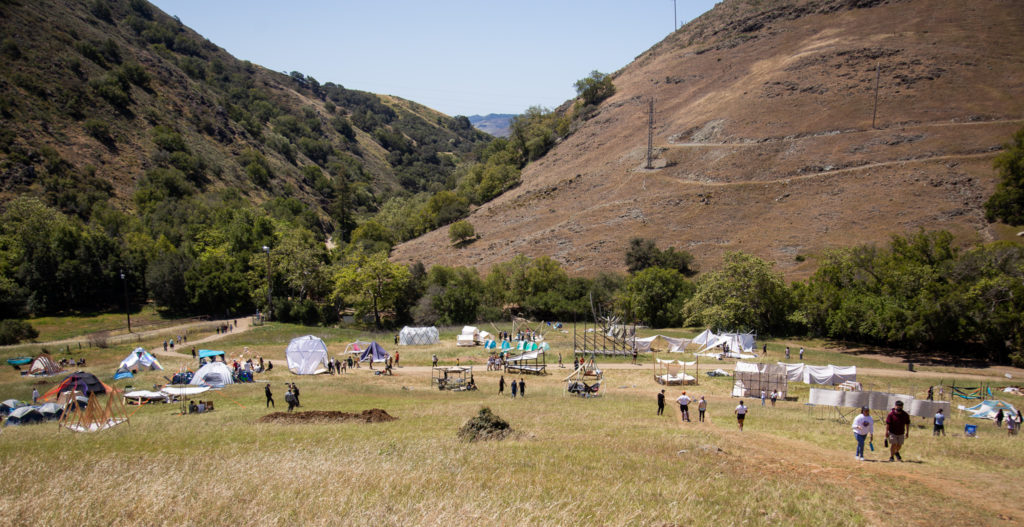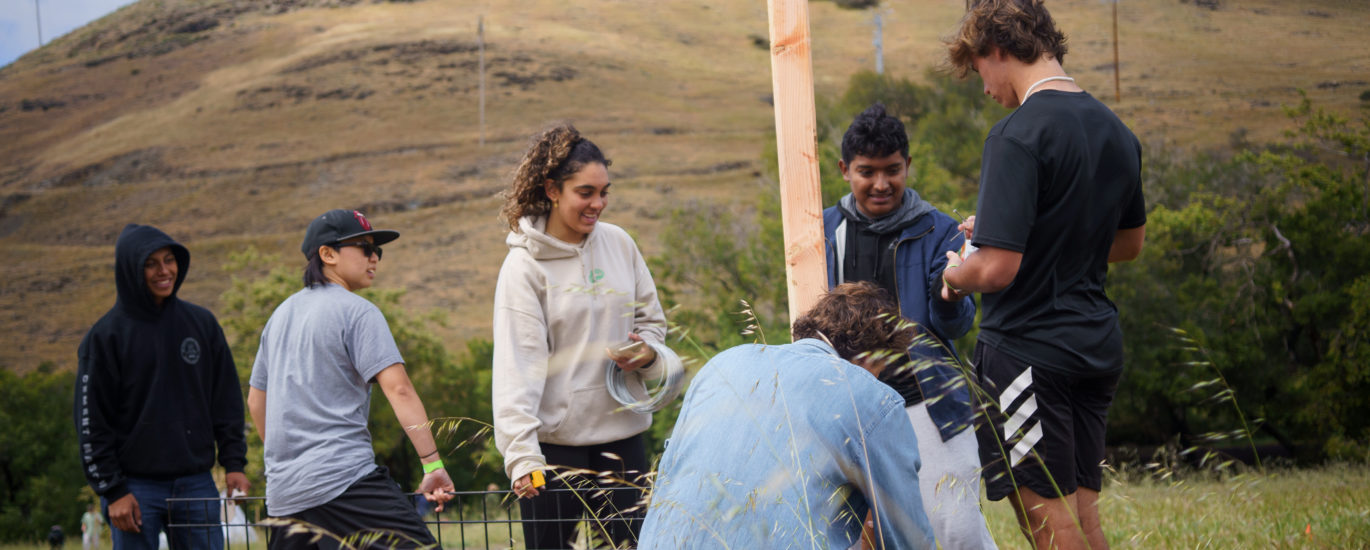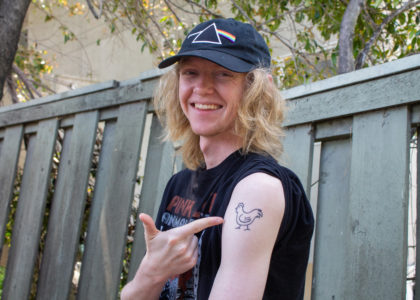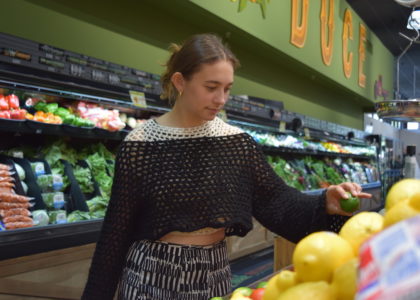By Amanda Wernik and Kaitlyn Shields
Mylinda Tran wiped beads of sweat from her forehead as she marched up the steep grassy hills of Poly Canyon holding a triangular canopy high above her head.
The hike against an incline was strenuous for the Cal Poly architecture freshman and her group mates, but Tran said the slopes were crucial to their structure’s design. “A big part of it was the slope and not trying to get rid of it, but rather to embrace it,” Tran said.
The group’s project, titled “Cascade,” was made of several triangles resembling a waterfall cascading down the hill. It was one of more than 80 structures that university students from across California hauled uphill on April 22 for the three-day Design Village 2022 competition on the outskirts of the Cal Poly campus.
Back and better than ever after a pandemic hiatus
Cal Poly won one out of the seven awards, and the others were granted to community colleges throughout the country. The people’s choice award was granted to Cal Poly’s team “Tumbleweed.” Some of the other awards included “best in theme, joy of habitation and people’s choice.”
This is the first time the competition has been held in person in two years due to the Covid-19 pandemic. This is the biggest Design Village to date, with 500 people competing.
Video by Alex Bires
An uphill battle
The hill of Poly Canyon proved to be a large struggle for the “Cascade” group as they had to imbed their structure into it. This, in turn, made it hard to create steady beds that weren’t falling at a slope and could be actually slept in. “Since the grommets were the main system holding up the canvas beds, all of the weight of the person and the tension of the rope caused them to rip,” Nasr said.
The group had to think on their feet and figure out a way to secure the beds better. After struggling and multiple trials and tribulations, Nasr said they were able to successfully sleep on the canvas at the end.
“Another challenge was carrying all the materials up to the architectural graveyard,” Nasr said, “We underestimated the weight of the grids and that carrying them together would hurt our fingers.”
The students camped for two nights in the structures they had designed and built by hand. This year’s theme for student structures was “Eternal,” which encouraged students to incorporate sustainable practices into their projects.
“Eternal” theme and sustainability in architecture
“Our professors emphasized finding a place to put our materials and reuse them instead of throwing them away,” said architecture freshman Zaina Nasr, who was also on the “Cascade” team.
Her group embodied the theme by building a sustainable structure comprised of long-lasting and recyclable materials, Nasr said.
The group plans to use the leftover canvas cloth to make tote bags, while the steel grid will be circulated back into classes for architecture students to use. Additionally, the structure is made of urban revival wood, a type of recycled wood.
“The next step is to figure out what we want screen printed on the bags, whether it’s our group logo or studio name,” Nasr said.
“Essentially, this wood is saved from trees that otherwise would have been burned and would have been bad from the environment, but they gave it to us to use for our project,” Tran said, “Keeping this in mind as architects and in how much we impact things will help us make decisions in the long run for the future in terms of materials.”
“11 V Tents” also drew its inspiration from the natural environment. Its design reflects the Pacific Ocean, according to team member and architecture sophomore Maggie Loll.
“It’s facing towards the west and then will wave toward the ocean,” Loll said.
The design resembles waves, with two sets of frames and a canvas and metal frame on top. The waves appear to be flowing down the hill, Loll said.
Unlike a lot of other groups, “Cascade” prepared most of their structure on-site, with minimal time to set up beforehand.
Nasr says the most rewarding part of the experience was finally completing the structure after several hours. “Even while constructing our structure, we had many doubts about how it was going to look all put together,” Nas
r said, “However, looking at the final product and having people compliment our group on our creativity was very heartwarming.”
That sort of creativity, hard work, and determination impressed Cal Poly advisor Angela Bracco, who said Design Village is one of her favorite events to participate in because of its meaningful impact on students’ lives.

“It’s one of my favorite projects,” she said, “These are all really exciting things for the students.”
Design Village Volunteer Director and Graphic Communications Taylor Tran attests to the rigorous dedication required of students for this event. “Planning is the most important because it’s tough to bring pieces up Poly
Canyon,” says Tran, “Strong team leadership is vital during these highly stressful moments to prevent any conflict from arising between members.”
Tran mainly focused her work on marketing the event to try and get as many people to come out and watch as possible. The Design Village was open to the public on Saturday, with live music and food, drawing in a diverse crowd.
Nasr, of the “Cascade” team, said sustainable design practices are becoming “part of a growing world” in architecture. A lot of modern-day waste comes from leftover parts from buildings, she said.
According to ScienceDirect, as much as 30 percent of all building materials delivered to a typical construction site can end up as waste.
“Since architects use a lot of materials, we have to make sure that they’re sustainable so that it doesn’t affect the environment,” Nasr said. “Having sustainable materials makes it better for everyone.”






